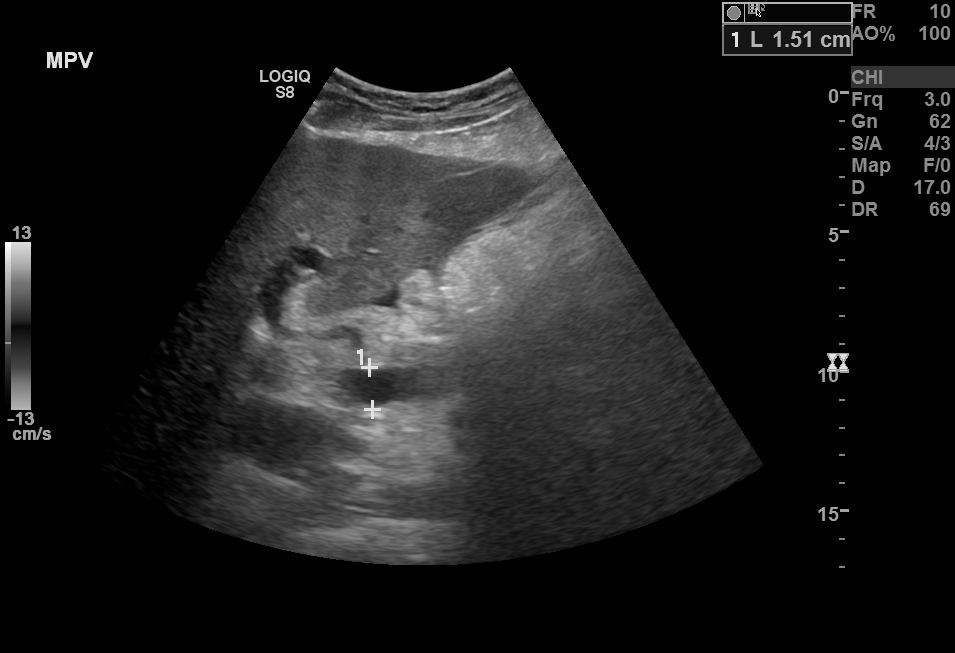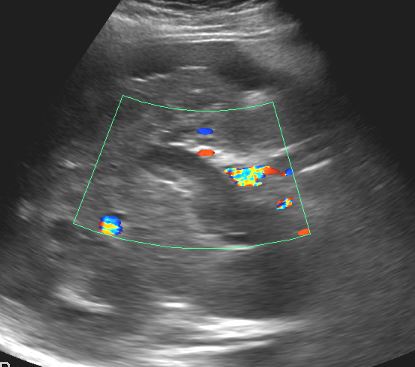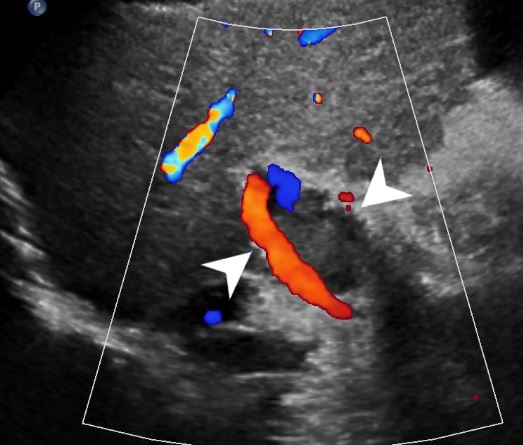[1]
Torres Rojas AM, Lorente S, Hautefeuille M, Sanchez-Cedillo A. Hierarchical Modeling of the Liver Vascular System. Frontiers in physiology. 2021:12():733165. doi: 10.3389/fphys.2021.733165. Epub 2021 Nov 16
[PubMed PMID: 34867439]
[2]
Eipel C, Abshagen K, Vollmar B. Regulation of hepatic blood flow: the hepatic arterial buffer response revisited. World journal of gastroenterology. 2010 Dec 28:16(48):6046-57
[PubMed PMID: 21182219]
[3]
Couinaud C. Liver anatomy: portal (and suprahepatic) or biliary segmentation. Digestive surgery. 1999:16(6):459-67
[PubMed PMID: 10805544]
[4]
Carneiro C, Brito J, Bilreiro C, Barros M, Bahia C, Santiago I, Caseiro-Alves F. All about portal vein: a pictorial display to anatomy, variants and physiopathology. Insights into imaging. 2019 Mar 21:10(1):38. doi: 10.1186/s13244-019-0716-8. Epub 2019 Mar 21
[PubMed PMID: 30900187]
Level 3 (low-level) evidence
[5]
Schmidt S, Demartines N, Soler L, Schnyder P, Denys A. Portal vein normal anatomy and variants: implication for liver surgery and portal vein embolization. Seminars in interventional radiology. 2008 Jun:25(2):86-91. doi: 10.1055/s-2008-1076688. Epub
[PubMed PMID: 21326549]
[6]
Hardy KJ. The hepatic veins. The Australian and New Zealand journal of surgery. 1972 Aug:42(1):11-4
[PubMed PMID: 4512537]
[7]
Fang CH, You JH, Lau WY, Lai EC, Fan YF, Zhong SZ, Li KX, Chen ZX, Su ZH, Bao SS. Anatomical variations of hepatic veins: three-dimensional computed tomography scans of 200 subjects. World journal of surgery. 2012 Jan:36(1):120-4. doi: 10.1007/s00268-011-1297-y. Epub
[PubMed PMID: 21976007]
[8]
Marchal G, Kint E, Nijssens M, Baert AL. Variability of the hepatic arterial anatomy: a sonographic demonstration. Journal of clinical ultrasound : JCU. 1981 Sep:9(7):377-81
[PubMed PMID: 6792236]
[9]
Tucker WD, Shrestha R, Burns B. Anatomy, Abdomen and Pelvis: Inferior Vena Cava. StatPearls. 2023 Jan:():
[PubMed PMID: 29493975]
[10]
McNaughton DA, Abu-Yousef MM. Doppler US of the liver made simple. Radiographics : a review publication of the Radiological Society of North America, Inc. 2011 Jan-Feb:31(1):161-88. doi: 10.1148/rg.311105093. Epub
[PubMed PMID: 21257940]
[11]
Ralls PW. Color Doppler sonography of the hepatic artery and portal venous system. AJR. American journal of roentgenology. 1990 Sep:155(3):517-25
[PubMed PMID: 2117348]
[12]
Wachsberg RH, Bahramipour P, Sofocleous CT, Barone A. Hepatofugal flow in the portal venous system: pathophysiology, imaging findings, and diagnostic pitfalls. Radiographics : a review publication of the Radiological Society of North America, Inc. 2002 Jan-Feb:22(1):123-40
[PubMed PMID: 11796903]
[13]
Suk KT. Hepatic venous pressure gradient: clinical use in chronic liver disease. Clinical and molecular hepatology. 2014 Mar:20(1):6-14. doi: 10.3350/cmh.2014.20.1.6. Epub 2014 Mar 26
[PubMed PMID: 24757653]
[14]
Kimura Y, Tapia Sosa R, Soto-Trujillo D, Kimura Sandoval Y, Casian C. Liver Transplant Complications Radiologist Can't Miss. Cureus. 2020 Jun 5:12(6):e8465. doi: 10.7759/cureus.8465. Epub 2020 Jun 5
[PubMed PMID: 32642371]
[15]
Crossin JD, Muradali D, Wilson SR. US of liver transplants: normal and abnormal. Radiographics : a review publication of the Radiological Society of North America, Inc. 2003 Sep-Oct:23(5):1093-114
[PubMed PMID: 12975502]
[16]
Kim MY, Jeong WK, Baik SK. Invasive and non-invasive diagnosis of cirrhosis and portal hypertension. World journal of gastroenterology. 2014 Apr 21:20(15):4300-15. doi: 10.3748/wjg.v20.i15.4300. Epub
[PubMed PMID: 24764667]
[17]
Baik SK. Haemodynamic evaluation by Doppler ultrasonography in patients with portal hypertension: a review. Liver international : official journal of the International Association for the Study of the Liver. 2010 Nov:30(10):1403-13. doi: 10.1111/j.1478-3231.2010.02326.x. Epub 2010 Aug 19
[PubMed PMID: 20731772]
[18]
Maruyama H, Yokosuka O. Ultrasonography for Noninvasive Assessment of Portal Hypertension. Gut and liver. 2017 Jul 15:11(4):464-473. doi: 10.5009/gnl16078. Epub
[PubMed PMID: 28267700]
[19]
Colli A, Fraquelli M, Andreoletti M, Marino B, Zuccoli E, Conte D. Severe liver fibrosis or cirrhosis: accuracy of US for detection--analysis of 300 cases. Radiology. 2003 Apr:227(1):89-94
[PubMed PMID: 12601199]
Level 3 (low-level) evidence
[20]
Bargalló X, Gilabert R, Nicolau C, García-Pagán JC, Ayuso JR, Brú C. Sonography of Budd-Chiari syndrome. AJR. American journal of roentgenology. 2006 Jul:187(1):W33-41
[PubMed PMID: 16794137]
[21]
Valla DC. Budd-Chiari syndrome/hepatic venous outflow tract obstruction. Hepatology international. 2018 Feb:12(Suppl 1):168-180. doi: 10.1007/s12072-017-9810-5. Epub 2017 Jul 6
[PubMed PMID: 28685257]
[22]
Chaubal N, Dighe M, Hanchate V, Thakkar H, Deshmukh H, Rathod K. Sonography in Budd-Chiari syndrome. Journal of ultrasound in medicine : official journal of the American Institute of Ultrasound in Medicine. 2006 Mar:25(3):373-9
[PubMed PMID: 16495498]
[23]
Manzano-Robleda Mdel C, Barranco-Fragoso B, Uribe M, Méndez-Sánchez N. Portal vein thrombosis: what is new? Annals of hepatology. 2015 Jan-Feb:14(1):20-7
[PubMed PMID: 25536638]
[24]
Chawla YK, Bodh V. Portal vein thrombosis. Journal of clinical and experimental hepatology. 2015 Mar:5(1):22-40. doi: 10.1016/j.jceh.2014.12.008. Epub 2015 Jan 6
[PubMed PMID: 25941431]
[25]
Foshager MC, Ferral H, Nazarian GK, Castañeda-Zúñiga WR, Letourneau JG. Duplex sonography after transjugular intrahepatic portosystemic shunts (TIPS): normal hemodynamic findings and efficacy in predicting shunt patency and stenosis. AJR. American journal of roentgenology. 1995 Jul:165(1):1-7
[PubMed PMID: 7785564]
[26]
Cura M, Cura A, Suri R, El-Merhi F, Lopera J, Kroma G. Causes of TIPS dysfunction. AJR. American journal of roentgenology. 2008 Dec:191(6):1751-7. doi: 10.2214/AJR.07.3534. Epub
[PubMed PMID: 19020247]
[27]
Benito A, Bilbao J, Hernández T, Martinez-Cuesta A, Larrache J, González I, Vivas I. Doppler ultrasound for TIPS: does it work? Abdominal imaging. 2004 Jan-Feb:29(1):45-52
[PubMed PMID: 15160753]
[28]
Naganuma H, Ishida H, Kuroda H, Suzuki Y, Ogawa M. Hereditary hemorrhagic telangiectasia: how to efficiently detect hepatic abnormalities using ultrasonography. Journal of medical ultrasonics (2001). 2020 Jul:47(3):421-433. doi: 10.1007/s10396-020-01022-w. Epub 2020 May 10
[PubMed PMID: 32390074]
[29]
Kang HJ, Lee JM, Jeon SK, Ryu H, Yoo J, Lee JK, Han JK. Microvascular Flow Imaging of Residual or Recurrent Hepatocellular Carcinoma after Transarterial Chemoembolization: Comparison with Color/Power Doppler Imaging. Korean journal of radiology. 2019 Jul:20(7):1114-1123. doi: 10.3348/kjr.2018.0932. Epub
[PubMed PMID: 31270975]
[30]
Maruyama H, Yoshikawa M, Yokosuka O. Current role of ultrasound for the management of hepatocellular carcinoma. World journal of gastroenterology. 2008 Mar 21:14(11):1710-9
[PubMed PMID: 18350602]
[31]
Jefkins M, Chan B. Hepatic and portal vein Dopplers in the clinical management of patients with right-sided heart failure: two case reports. The ultrasound journal. 2019 Nov 12:11(1):30. doi: 10.1186/s13089-019-0146-3. Epub 2019 Nov 12
[PubMed PMID: 31748951]
Level 3 (low-level) evidence
[32]
Afif AM, Chang JP, Wang YY, Lau SD, Deng F, Goh SY, Pwint MK, Ooi CC, Venkatanarasimha N, Lo RH. A sonographic Doppler study of the hepatic vein, portal vein and hepatic artery in liver cirrhosis: Correlation of hepatic hemodynamics with clinical Child Pugh score in Singapore. Ultrasound (Leeds, England). 2017 Nov:25(4):213-221. doi: 10.1177/1742271X17721265. Epub 2017 Aug 3
[PubMed PMID: 29163657]
[33]
Carovac A, Smajlovic F, Junuzovic D. Application of ultrasound in medicine. Acta informatica medica : AIM : journal of the Society for Medical Informatics of Bosnia & Herzegovina : casopis Drustva za medicinsku informatiku BiH. 2011 Sep:19(3):168-71. doi: 10.5455/aim.2011.19.168-171. Epub
[PubMed PMID: 23408755]
[35]
Macnaught F, Campbell-Rogers N. The liver: how we do it. Australasian journal of ultrasound in medicine. 2009 Aug:12(3):44-47. doi: 10.1002/j.2205-0140.2009.tb00061.x. Epub 2015 Dec 31
[PubMed PMID: 28191063]
[36]
Geleto G, Getnet W, Tewelde T. Mean Normal Portal Vein Diameter Using Sonography among Clients Coming to Radiology Department of Jimma University Hospital, Southwest Ethiopia. Ethiopian journal of health sciences. 2016 May:26(3):237-42
[PubMed PMID: 27358544]
[37]
Patil S, Jadhav S, Shetty N, Kharge J, Puttegowda B, Ramalingam R, Cholenahally MN. Assessment of inferior vena cava diameter by echocardiography in normal Indian population: A prospective observational study. Indian heart journal. 2016 Dec:68 Suppl 3(Suppl 3):S26-S30. doi: 10.1016/j.ihj.2016.06.009. Epub 2016 Jul 1
[PubMed PMID: 28038721]
Level 2 (mid-level) evidence
[38]
Francoz C, Valla D, Durand F. Portal vein thrombosis, cirrhosis, and liver transplantation. Journal of hepatology. 2012 Jul:57(1):203-12. doi: 10.1016/j.jhep.2011.12.034. Epub 2012 Mar 21
[PubMed PMID: 22446690]
[39]
Tanaka H. Current role of ultrasound in the diagnosis of hepatocellular carcinoma. Journal of medical ultrasonics (2001). 2020 Apr:47(2):239-255. doi: 10.1007/s10396-020-01012-y. Epub 2020 Mar 13
[PubMed PMID: 32170489]
[40]
Ricci P, Cantisani V, Lombardi V, Alfano G, D'Ambrosio U, Menichini G, Marotta E, Drudi FM. Is color-Doppler US a reliable method in the follow-up of transjugular intrahepatic portosystemic shunt (TIPS)? Journal of ultrasound. 2007 Mar:10(1):22-7. doi: 10.1016/j.jus.2007.02.005. Epub 2007 Apr 16
[PubMed PMID: 23396711]
[41]
Aggeletopoulou I, Konstantakis C, Manolakopoulos S, Triantos C. Role of band ligation for secondary prophylaxis of variceal bleeding. World journal of gastroenterology. 2018 Jul 14:24(26):2902-2914. doi: 10.3748/wjg.v24.i26.2902. Epub
[PubMed PMID: 30018485]



